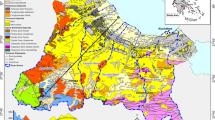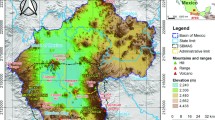Abstract
The spatial variability evaluation of the water table level of an aquifer provides useful information in water resources management plans. Three different approaches are applied to estimate the spatial variability of the water table in the study basin. All of them are based on the Kriging methodology. The first is the classical Ordinary Kriging approach, while the second involves information from a secondary variable (surface elevation) and the application of Residual Kriging. The third calculates the probability to lie below a certain groundwater level limit that could cause significant problems in groundwater resources availability. The latter is achieved by means of Indicator Kriging. A recently developed non-linear normalization method is used to transform both data and residuals closer to normal distribution for improved prediction results. In addition, the recently developed Spartan variogram model is applied to determine the spatial dependence of the measurements. The latter proves to be the optimal model, compared to a series of models tested, which provides in combination with the Kriging methodologies the most accurate cross validation estimations. The variogram form is explained with respect to the radius of influence of the pumping wells representing the spatial impact of the pumping activity. Groundwater level and probability maps are developed providing the ability to assess the spatial variability of the groundwater level in the basin and the risk that certain locations have in terms of a safe groundwater level limit that has been set for the sustainability of the groundwater resources of the basin.











Similar content being viewed by others
References
Ahmadi S, Sedghamiz A (2007) Geostatistical analysis of spatial and temporal variations of groundwater level. Environ Monit Assess 129(1):277–294
Anane M, Selmi Y, Limam A, Jedidi N, Jellali S (2014) Does irrigation with reclaimed water significantly pollute shallow aquifer with nitrate and salinity? An assay in a perurban area in North Tunisia. Environ Monit Assess 186(7):4367–4390
Armstrong M (1998) Basic linear geostatistics. Springer Verlag, Berlin
Arslan H (2012) Spatial and temporal mapping of groundwater salinity using ordinary kriging and indicator kriging: the case of Bafra Plain, Turkey. Agric Water Manag 113:57–63
Buchanan S, Triantafilis J (2009) Mapping water table depth using geophysical and environmental variables. Ground Water 47(1):80–96
Chica-Olmo M, Luque-Espinar JA, Rodriguez-Galiano V, Pardo-Igúzquiza E, Chica-Rivas L (2014) Categorical Indicator Kriging for assessing the risk of groundwater nitrate pollution: the case of Vega de Granada aquifer (SE Spain). Sci Total Environ 470–471:229–239
Chiles JP, Delfiner A (1999) Geostatistics (modeling spatial uncertainty). Wiley, New York
Chorti A, Hristopulos DT (2008) Non-parametric identification of anisotropic (elliptic) correlations in spatially distributed data sets. IEEE Trans Signal Process 56(10):4738–4751
Christakos G (1991) Random field models in earth sciences. Academic, San Diego
Chung J-W, Rogers JD (2012) Interpolations of groundwater table elevation in dissected uplands. Ground Water 50(4):598–607
Clark I, Harper WV (2000) Practical geostatistics 2000. Ecosse North America Llc., Columbus
Cressie N (1993) Statistics for spatial data (revised ed.). Wiley, New York
Demir Y, Erşahin S, Güler M, Cemek B, Günal H, Arslan H (2009) Spatial variability of depth and salinity of groundwater under irrigated ustifluvents in the Middle Black Sea Region of Turkey. Environ Monit Assess 158(1–4):279–294
Desbarats AJ, Logan CE, Hinton MJ, Sharpe DR (2002) On the kriging of water table elevations using collateral information from a digital elevation model. J Hydrol 255(1–4):25–38
Deutsch CV, Journel AG (1992) GSLIB. Geostatistical software library and user’s guide. . Oxford University Press, New York
Draper N, Smith H (1981) Applied regression analysis, 2nd edn. Wiley, New York
Elogne SN, Hristopulos DT (2008) Geostatistical applications of Spartan spatial random fields. In: Soares A, Pereira MJ, Dimitrakopoulos R (eds) geoENV VI—geostatistics for environmental applications in series: quantitative geology and geostatistics, vol 15. Springer, Berlin, pp 477–488
Elogne S, Hristopulos D, Varouchakis E (2008) An application of Spartan spatial random fields in environmental mapping: focus on automatic mapping capabilities. Stoch Env Res Risk A 22(5):633–646
Goovaerts P (1997) Geostatistics for natural resources evaluation. Oxford University Press, New York
Goovaerts P (1999) Geostatistics in soil science: state-of-the-art and perspectives. Geoderma 89(1–2):1–45
Goovaerts P, AvRuskin G, Meliker J, Slotnick M, Jacquez G, Nriagu J (2005) Geostatistical modeling of the spatial variability of arsenic in groundwater of southeast Michigan. Water Resour Res 41, W07013. doi:10.1029/2004WR003705
Gringarten E, Deutsch CV (2001) Teacher’s aide: variogram interpretation and modeling. Math Geol 33(2001):507–534
Haitjema HM, Mitchell-Bruker S (2005) Are water tables a subdued replica of the topography? Ground Water 43(6):781–786
Hengl T (2007) A practical guide to geostatistical mapping of environmental variables. Office for Official Publications of the European Communities EUR 22904 EN-Scientific and Technical Research series 143
Hengl T, Heuvelink GBM, Stein A (2003) Comparison of kriging with external drift and regression-kriging. International Institute for Geo-information Science and Earth Observation (ITC) Technical note 17
Hengl T, Heuvelink GBM, Rossiter DG (2007) About regression-kriging: from equations to case studies. Comput Geosci 33(10):1301–1315
Hoeksema RJ, Clapp RB, Thomas AL, Hunley AE, Farrow ND, Dearstone KC (1989) Cokriging model for estimation of water table elevation. Water Resour Res 25(3):429–438
Hohn ME (1999) Geostatistics and petroleum geology. Springer, Dordrecht
Hristopulos DT (2002) New anisotropic covariance models and estimation of anisotropic parameters based on the covariance tensor identity. Stoch Env Res Risk A 16(1):43–62
Hristopulos DT (2003) Spartan Gibbs random field models for geostatistical applications. SIAM J Sci Comput 24(6):2125–2162
Hristopulos DT, Elogne SN (2007) Analytic properties and covariance functions for a new class of generalized Gibbs random fields. IΕΕΕ Trans Inform Theory 53(12):4667–4679
Hristopulos DT, Elogne SN (2009) Computationally efficient spatial interpolators based on Spartan spatial random fields. IEEE Trans Signal Process 57(9):3475–3487
Isaaks EH, Srivastava RM (1989) An introduction to applied geostatisics. Oxford University Press, New York
Journel AG, Huijbregts C (1978) Mining geostatistics. Academic, New York
Kanevski M, Pozdnoukhov A, Timonin V (2009) Machine learning for spatial environmental data: theory, applications, and software. EPFL press, Lausanne
Kitanidis P (1993) Generalized covariance functions in estimation. Math Geol 25(5):525–540
Liu C-W, Jang C-S, Liao C-M (2004) Evaluation of arsenic contamination potential using indicator kriging in the Yun-Lin aquifer (Taiwan). Sci Total Environ 321(1–3):173–188
Lyon SW, Lembo AJ Jr, Walter MT, Steenhuis TS (2006a) Defining probability of saturation with indicator kriging on hard and soft data. Adv Water Resour 29(2):181–193
Lyon SW, Seibert J, Lembo AJ, Walter MT, Steenhuis TS (2006b) Geostatistical investigation into the temporal evolution of spatial structure in a shallow water table. Hydrol Earth Syst Sci 10(1):113–125
Massey FJ (1951) The Kolmogorov-Smirnov test for goodness of fit. J Am Stat Assoc 46(253):68–78
Moukana JA, Koike K (2008) Geostatistical model for correlating declining groundwater levels with changes in land cover detected from analyses of satellite images. Comput Geosci 34(11):1527–1540
Nelder JA, Mead R (1965) A simplex method for function minimization. Comput J 7(4):308–313
Neshat A, Pradhan B, Javadi S (2015) Risk assessment of groundwater pollution using Monte Carlo approach in an agricultural region: an example from Kerman Plain, Iran. Comput Environ Urban Syst 50:66–73
Neuman S, Jacobson E (1984) Analysis of nonintrinsic spatial variability by residual kriging with application to regional groundwater levels. Math Geol 16(5):499–521
Nikroo L, Kompani-Zare M, Sepaskhah A, Fallah Shamsi S (2009) Groundwater depth and elevation interpolation by kriging methods in Mohr Basin of Fars province in Iran. Environ Monit Assess 166(1–4):387–407
Olea RA (1999) Geostatistics for engineers and earth scientists. Kluwer Academic Publishers, New York
Ouyang Y, Zhang JE, Ou LT (2006) Temporal and spatial distribution of sediment total organic carbon in an estuary river. J Environ Qual 35(1):93–100
Papadopoulou MP, Varouchakis EA, Karatzas GP (2009) Simulation of complex aquifer behavior using numerical and geostatistical methodologies. Desalination 237(1–3):42–53
Pardo-Iguzquiza E, Dowd P (2005) Empirical maximum likelihood Kriging: the general case. Math Geol 37(5):477–492
Press WH, Teukolsky SA, Vettering WT, Flannery BP (1992) Numerical recipes in fortran, 2nd edn. Cambridge University Press, New York
Rivest M, Marcotte D, Pasquier P (2008) Hydraulic head field estimation using kriging with an external drift: a way to consider conceptual model information. J Hydrol 361(3–4):349–361
Rivoirard J (2002) On the structural link between variables in Kriging with external drift. Math Geol 34(7):797–808
Spiliopoulos I, Hristopulos DT, Petrakis E, Chorti A (2011) A Multigrid method for the estimation of geometric anisotropy in environmental data from sensor networks. Comput Geosci 37(3):320–330
Sun Y, Kang S, Li F, Zhang L (2009) Comparison of interpolation methods for depth to groundwater and its temporal and spatial variations in the Minqin oasis of northwest China. Environ Model Softw 24(10):1163–1170
Theodossiou N, Latinopoulos P (2006) Evaluation and optimisation of groundwater observation networks using the kriging methodology. Environ Model Softw 21(7):991–1000
Tichy M (1993) Applied methods of structural reliability. Springer, Dordrecht
Varouchakis EA (2012) Geostatistical analysis and space-time models of aquifer levels: application to mires hydrological basin in the prefecture of crete. PhD Thesis, Mineral Resources Engineering, Technical University of Crete, Chania
Varouchakis EA (2016) Integrated water resources analysis at basin scale: a case study in Greece. J Irrig Drain. E-ASCE 142(3). doi:10.1061/(ASCE)IR.1943-4774.0000966
Varouchakis EA, Hristopulos DT (2013a) Comparison of stochastic and deterministic methods for mapping groundwater level spatial variability in sparsely monitored basins. Environ Monit Assess 185(1):1–19
Varouchakis EA, Hristopulos DT (2013b) Improvement of groundwater level prediction in sparsely gauged basins using physical laws and local geographic features as auxiliary variables. Adv Water Resour 52(2013):34–49
Varouchakis EA, Hristopulos DT, Karatzas GP (2012) Improving kriging of groundwater level data using nonlinear normalizing transformations-a field application. Hydrol Sci J 57(7):1404–1419
Webster R, Oliver M (2001) Geostatistics for environmental scientists: statistics in practice. Wiley, Chichester
Witten IH, Frank E, Hall MA (2011) Data mining: practical machine learning tools and techniques: practical machine learning tools and techniques. Elsevier, San Francisco
Žukovič M, Hristopulos DT (2008) Environmental time series interpolation based on Spartan random processes. Atmos Environ 42(33):7669–7678
Author information
Authors and Affiliations
Corresponding author
Additional information
Communicated by: H. A. Babaie
Rights and permissions
About this article
Cite this article
Varouchakis, E.A., Kolosionis, K. & Karatzas, G.P. Spatial variability estimation and risk assessment of the aquifer level at sparsely gauged basins using geostatistical methodologies. Earth Sci Inform 9, 437–448 (2016). https://doi.org/10.1007/s12145-016-0265-3
Received:
Accepted:
Published:
Issue Date:
DOI: https://doi.org/10.1007/s12145-016-0265-3




